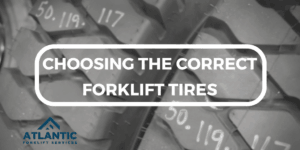You, your forklift and its tires have a very special relationship. The forklift can’t really do its job without the tires, and the tires you select can make your job easier. However, choosing the right forklift tires isn’t as easy as taking the ones that come with the unit when you buy it. There’s much more to it than that.
For example, will your lift be working on an even, or uneven surface? Pneumatic tires have air in them, which acts as a shock absorber of sorts on uneven surfaces. Solid pneumatics lack the air cushion- they give you the same ground clearance as the air-filled pneumatics, but lack shock-absorber effect. However, solid pneumatic tire will never go flat.
Cushion tires are great on nice, shiny, smooth warehouse floors.
If the appearance of that nice, shiny, smooth warehouse floor matters to you, you’ll want to consider non-marking tires. They’re used on floors where you don’t want to leave skid marks behind. Be aware, though, they’re softer and wear out faster than black tires.
Your forklift tires, much like your car tires, need a little maintenance and need to be checked periodically. When the tread is gone on a pneumatic tire or a treaded cushion tire, it’s time to put that tire to rest.
On smooth cushion tires, when the tire wears down to the size stamp on the side wall of the tire, it’s time.
Caution! Solid pneumatic tires and cushion tires suffer from what the tire people refer to as “chunking.” That’s when the tire gets damaged in a way that large pieces (chunks) get ripped form the tire. If this happens, or if your tires side walls get cut or they get punctured, it’s best to have that tire checked out to see if it can be repaired as soon as you can.
As far as the bottom line, the cost of your forklift tires depends on the size of your lift. Choosing the right tires for your forklift matters.
Contact us! We’ll answer your questions and steer you towards the right tires.

